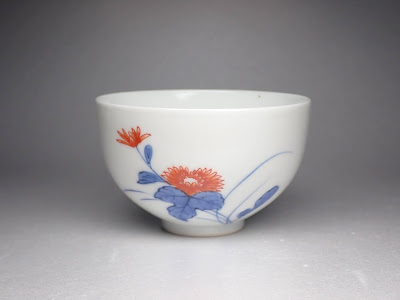鍋島色絵 菊花文猪口 Chrysanthemum Nabeshima Cup
口径 top width: 83 mm / 高台径 bottom width: 33 mm / 高さ height: 51 mm
これは伊万里焼の中心地である有田から 5 km あまり北に位置する伊万里市大川内町で焼かれた鍋島焼の猪口である。ここは江戸時代、当地を治めていた佐賀藩(鍋島藩)直轄の窯があったところで、最高の職人をかかえて、当時得られるもっとも上質な土と釉薬をもちいて、幕府等への献上品を少量のみ生産した。その作陶技術は外にもれないよう厳重に管理されたという。この作品は、鍋島焼全盛期の17世紀後半〜18世紀初頭のものにくらべたら簡素で見劣りするが、それでも凛とした薄造りの器体や、絵付けの手慣れた感じは、ふつうの古伊万里とのちがいを感じさせる。
10年以上前に東京・青山にあったたさぶろうという店(いまはない)で手に入れた。わたしはのぞき猪口みたいな小さな猪口に興味があって、それ以外の古伊万里はあまり買う気はなかったのだが、店主があまりにすすめてくるのでおもわず買ってしまった。
This cup is a Nabeshima ware made in Okawachi-cho, Imari City, about 5 km north from Arita, the ceter of Imari-ware production. Nabeshima ware was a special Imari ware managed by the local governor and crafted by selected potters with the best-quality clay and glaze as gifts for the Edo shogunate of Japan. The production technique was strictly protected not to be imitated. The above cup is so simple that it is much inferior to the Nabeshima wares in the late 17th and the early 18th century. However, the thin body and skillful drawing are enough to remind me that it is still a Nabeshima ware. I obtained it at an antique shop, Tasaburo, in Aoyama, Tokyo, more than 10 years ago. I was fond of small Imari cups like nozoki, but bought it because the shop owner recommended so strongly.
The flower will be chrysanthemum (kiku).
The bottom part is also skillfully crafted. This cup would be used as a tea (sencha) cup.
補足
鍋島焼は本焼きまでを大川内町でおこない、色絵(上絵付け)は有田の赤絵町でなされたのだそうだ。この色絵付けをおこなっていたのが今泉今右衛門家といわれていて、現在も有田で色絵磁器をつくっている。
19世紀の鍋島焼(後期鍋島)は近年研究が進んで徐々にその芸術的価値が認められるようになってきた、と骨董屋の主人が言っていた。小木一良「鍋島 後期の作風を観る3」(創樹社美術出版、2008年)などの本が出ているみたいだ(わたしは読んでない)。
明治になると鍋島藩の御用窯は閉じられたが、その技術は精巧社という会社によっておなじ大川内町の地で継承された。この作品も明治期のものかもしれない。


